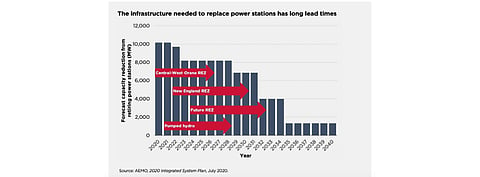

The Australian state of New South Wales (NSW) has unveiled an AUD 32 billion ($23 billion) Electricity Infrastructure Roadmap. This roadmap provides a 20-year plan during which the state will deliver its Renewable Energy Zones (REZ), energy storage including pumped hydro and on demand supply like gas and batteries aiming to reduce emissions and ensure cheap, reliable electricity.
The plan translates into ensuring 12 GW of new renewable energy capacity to come online by 2040 as the state government looks to deliver new transmission capacity through Central West Orana, New England and South West REZ by 2030 and 'even more over time'. The Central West and New England REZs will be delivered by 2030, according to the state's Deputy Premier John Barilaro.
At the same time, the plan will support the private sector to bring up 2 GW of storage as pumped hydro online by 2030.
With an official roadmap, the government wants to cut red-tape to speed up approvals for transmission infrastructure in REZ. The plan is the government's way of ensuring electricity supply for the state when 4 of its 5 coal power stations, accounting for 3 quarters of state electricity supply, are expected to shutter in next 15 years, starting with Liddell Power Station in 2022-23. "The cheapest replacement infrastructure we need has long construction times. It can take up to 10 years to build a Renewable Energy Zone and eight years to build a large pumped hydro project," reads the roadmap.
"The stimulus the Renewable Energy Zones will provide to regional communities will unlock over 9,000 new jobs and will be a huge boost to farmers and land owners, with AUD 1.5 billion ($1.09 billion) in lease payments expected to go to landholders hosting new infrastructure by 2042," added Barilaro.
The detailed roadmap can be viewed on the state's Ministry of Planning, Industry and Environment website.
In May 2020, NSW had sought interest for 3 GW renewable energy capacity for Central West REZ in response to which it received a whopping 27 GW in response (see NSW Receives 27 GW Interest For 3 GW REZ). For New England REZ, it has fixed 8 GW capacity expecting AUD 79 million investment (see 8 GW New England RE Zone In New South Wales). Another 1 GW will be built as allowance for outstanding projects by 2030 and otherwise to maintain reliability and minimize consumer prizes, as per current plans.
In March 2020, the NSW government said it wanted 17.7 GW of renewable energy capacity to be grid connected through 3 REZ to help state achieve its net zero emissions by 2050 (see New South Wales Targets 17.7 GW Grid Connected RE).
Renewable energy industry is happy
Clean Energy Council's Chief Executive Kane Thornton was all praise for the roadmap that he said sets NSW up to be the country's top destination for renewable energy investment over the coming decade.
"It will provide tremendous confidence to private investors about when and where new generation is needed, while resolving a number of the key barriers to investment, such as access to the necessary transmission capacity, investment certainty through long-term energy services agreements and addressing slow and costly planning processes," explained Thornton.
He also cautioned that implications for existing generators within REZs should be considered so as not to jeopardize their value.
